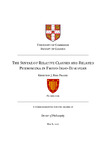In this thesis, I reconstruct the syntax of relative clauses in Proto-Indo-European (PIE). Syntactic reconstruction, particularly in the case of PIE, has presented a perennial challenge to Comparative Philologists. I demonstrate that Minimalist reconstruction provides a viable methodology through which we may address this challenge, integrating the specific task of reconstruction into the broader field of historical syntax. The methodology necessarily demands a discussion of Minimalist theories of relative clause structures, which I provide in relation to the synchronic analysis of ancient Indo-European (IE) languages. I then undertake a philological survey of descendants of the putative relative pronouns in PIE: *yó- and *kʷí-/*kʷó-. The debate on which (if either) of these was the “original” relative pronoun in PIE has lasted for over a century. I argue that neither form can be excluded as a relative pronoun in PIE, and that together they reflect what was a unitary functional category: the relative pronoun, *REL. Relative clauses across the ancient IE languages exhibit grammaticalised fronting of the relative pronoun, traditionally referred to as “wh-movement”. To analyse the nature of this movement, I provide a detailed reconstruction of the PIE left periphery. Because of the additional role of discourse-driven movement (Topicalisation and Focalisation) and clisis (“Wackernagel’s Law”) in the left periphery, my reconstruction has implications beyond relative clauses, shaping our understanding of the significant role pragmatics plays in the ordering of constituents in PIE, as well as the syntax-phonology interface. On the basis of all the above, I reconstruct the syntax of relative clauses in PIE. I argue that PIE had what I refer to as an “anaphoric” relative clause, that could generate a variety of surface forms, including correlatives and postnominal relatives. The “anaphoric” relative clause was adjoined to the matrix clause at the CP level, and could either precede or follow the matrix clause. I argue further that we cannot exclude embedded relative clauses from our reconstruction of PIE, but that it is possible to derive them diachronically from an earlier “anaphoric” relative clause. This thesis thus demonstrates that Minimalist reconstruction is not only a viable methodology, but a fruitful one, allowing us to establish concrete conclusions about PIE syntax.
Advisors
Thompson, RupertClackson, JamesDate
2022-03-18Awarding Institution
University of CambridgeQualification
Doctor of Philosophy (PhD)Type
ThesisMetadata
Show full item recordAbstract
In this thesis, I reconstruct the syntax of relative clauses in Proto-Indo-European (PIE). Syntactic reconstruction, particularly in the case of PIE, has presented a perennial challenge to Comparative Philologists. I demonstrate that Minimalist reconstruction provides a viable methodology through which we may address this challenge, integrating the specific task of reconstruction into the broader field of historical syntax. The methodology necessarily demands a discussion of Minimalist theories of relative clause structures, which I provide in relation to the synchronic analysis of ancient Indo-European (IE) languages. I then undertake a philological survey of descendants of the putative relative pronouns in PIE: *yó- and *kʷí-/*kʷó-. The debate on which (if either) of these was the “original” relative pronoun in PIE has lasted for over a century. I argue that neither form can be excluded as a relative pronoun in PIE, and that together they reflect what was a unitary functional category: the relative pronoun, *REL. Relative clauses across the ancient IE languages exhibit grammaticalised fronting of the relative pronoun, traditionally referred to as “wh-movement”. To analyse the nature of this movement, I provide a detailed reconstruction of the PIE left periphery. Because of the additional role of discourse-driven movement (Topicalisation and Focalisation) and clisis (“Wackernagel’s Law”) in the left periphery, my reconstruction has implications beyond relative clauses, shaping our understanding of the significant role pragmatics plays in the ordering of constituents in PIE, as well as the syntax-phonology interface. On the basis of all the above, I reconstruct the syntax of relative clauses in PIE. I argue that PIE had what I refer to as an “anaphoric” relative clause, that could generate a variety of surface forms, including correlatives and postnominal relatives. The “anaphoric” relative clause was adjoined to the matrix clause at the CP level, and could either precede or follow the matrix clause. I argue further that we cannot exclude embedded relative clauses from our reconstruction of PIE, but that it is possible to derive them diachronically from an earlier “anaphoric” relative clause. This thesis thus demonstrates that Minimalist reconstruction is not only a viable methodology, but a fruitful one, allowing us to establish concrete conclusions about PIE syntax.Keywords
Proto-Indo-European, Syntax, Relative clause, Reconstruction, Comparative Philology, LinguisticsSponsorship
Arts and Humanities Research Council (2107829)Identifiers
This record's DOI: https://doi.org/10.17863/CAM.90273


No comments:
Post a Comment